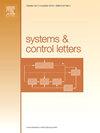基于线性到达时差测量定位的分布式目标跟踪:容时网络估算方法
IF 2.1
3区 计算机科学
Q3 AUTOMATION & CONTROL SYSTEMS
引用次数: 0
摘要
本文研究了基于信标信号对一组协同传感器的到达时间差(TDOA)的目标跟踪问题。传感器接收来自目标的反射信号,其中到达时间(TOA)呈现距离信息。现有的方法包括:(i)经典的集中式解决方案,在一个中心单元收集和处理目标数据;(ii)分布式解决方案,假设目标数据在每个传感器的密集邻域中是可观察到的(在局部进行过滤);(iii)双时间尺度分布式方法,在网络上具有高通信/共识率。为了降低(i)-(ii)中的网络连通性和(iii)中的通信速率,本工作提出了一种分布式单时间尺度技术,该技术还可以处理静态传感器网络上的异构恒定数据交换延迟。本工作仅假设分布式可观察性(与(ii)中分类的一些现有工作中的局部可观察性相反),即目标在(强)连接网络上是全局可观察的。(强)连接性进一步允许可生存网络和q冗余观察者设计。每个传感器在本地共享信息,并通过局部线性矩阵不等式(LMI)反馈增益对接收到的数据进行处理,以保证跟踪误差的稳定性。相同的增益矩阵在存在异构延迟的情况下工作,不需要重新设计算法。由于大多数现有的分布式估计场景是线性的(基于共识),许多工作使用现有的非线性TDOA测量模型的线性化,其中输出矩阵是目标位置的函数。由于确切的目标位置是未知的,现有的工作使用输出矩阵(以及增益设计)在每个时间步长的估计位置。这使得他们的算法更复杂,更不准确。相反,这项工作提供了一个改进的线性TDOA测量模型,该模型具有恒定的输出矩阵,与目标位置无关,在分布式线性设置中更实用。本文章由计算机程序翻译,如有差异,请以英文原文为准。

Distributed target tracking based on localization with linear time-difference-of-arrival measurements: A delay-tolerant networked estimation approach
This paper considers target tracking based on a beacon signal’s time-difference-of-arrival (TDOA) to a group of cooperating sensors. The sensors receive a reflected signal from the target where the time-of-arrival (TOA) renders the distance information. The existing approaches include: (i) classic centralized solutions which gather and process the target data at a central unit, (ii) distributed solutions which assume that the target data is observable in the dense neighborhood of each sensor (to be filtered locally), and (iii) double time-scale distributed methods with high rates of communication/consensus over the network. This work, in order to reduce the network connectivity in (i)-(ii) and communication rate in (iii), proposes a distributed single time-scale technique, which can also handle heterogeneous constant data-exchange delays over the static sensor network. This work assumes only distributed observability (in contrast to local observability in some existing works categorized in (ii)), i.e., the target is observable globally over a (strongly) connected network. The (strong) connectivity further allows for survivable network and -redundant observer design. Each sensor locally shares information and processes the received data in its immediate neighborhood via local linear-matrix-inequalities (LMI) feedback gains to ensure tracking error stability. The same gain matrix works in the presence of heterogeneous delays with no need of redesigning algorithms. Since most existing distributed estimation scenarios are linear (based on consensus), many works use linearization of the existing nonlinear TDOA measurement models where the output matrix is a function of the target position. As the exact target position is unknown, the existing works use estimated position in the output matrix (and for the gain design) at every time step. This makes their algorithm more complex and less accurate. Instead, this work provides a modified linear TDOA measurement model with a constant output matrix that is independent of target position and more practical in distributed linear setups.
求助全文
通过发布文献求助,成功后即可免费获取论文全文。
去求助
来源期刊

Systems & Control Letters
工程技术-运筹学与管理科学
CiteScore
4.60
自引率
3.80%
发文量
144
审稿时长
6 months
期刊介绍:
Founded in 1981 by two of the pre-eminent control theorists, Roger Brockett and Jan Willems, Systems & Control Letters is one of the leading journals in the field of control theory. The aim of the journal is to allow dissemination of relatively concise but highly original contributions whose high initial quality enables a relatively rapid review process. All aspects of the fields of systems and control are covered, especially mathematically-oriented and theoretical papers that have a clear relevance to engineering, physical and biological sciences, and even economics. Application-oriented papers with sophisticated and rigorous mathematical elements are also welcome.
 求助内容:
求助内容: 应助结果提醒方式:
应助结果提醒方式:


